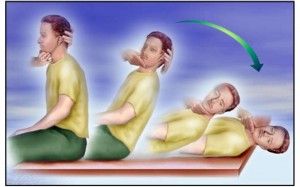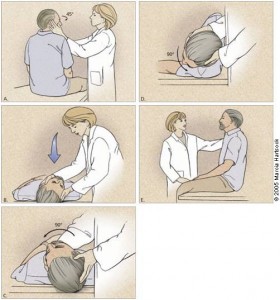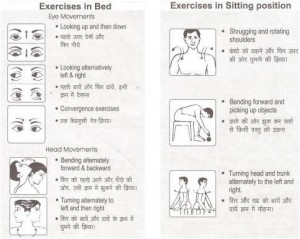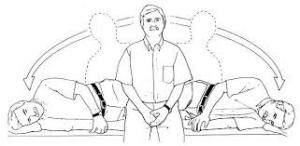Vertigo (from the Latin vert? “a whirling or spinning movement”) is a type of dizziness, where there is a feeling of motion when one is stationary. The symptoms are due to a dysfunction of the vestibular system in the inner ear. It is often associated with nausea and vomiting as well as difficulties standing or walking.
The most common causes are benign paroxysmal positional vertigo and vestibular migraine while less common causes include Ménière’s disease and vestibular neuritis. Excessive consumption of alcohol can also cause vertigo. Repetitive spinning, as in familiar childhood games, can induce short-lived vertigo by disrupting the inertia of the fluid in the vestibular system.
Vertigo is classified into either peripheral or central depending on the location of the dysfunction of the vestibular pathway.
Peripheral vertigo
Vertigo caused by problems with the inner ear or vestibular system is called peripheral vertigo. The most common cause is benign paroxysmal positional vertigo (BPPV) but other causes include Ménière’s disease and labyrinthitis. Any cause of inflammation such as common cold, influenza, and bacterial infections may cause transient vertigo if they involve the inner ear, as may chemical insults (e.g., aminoglycosides) or physical trauma (e.g., skull fractures). Motion sickness is sometimes classified as a cause of peripheral vertigo.
Central vertigo
If vertigo arises from the balance centers of the brain, it is usually milder, and has accompanying neurologic deficits, such as slurred speech, double vision or pathologic nystagmus.
A number of conditions that involve the central nervous system may lead to vertigo including: migraine headaches, lateral medullary syndrome, multiple sclerosis.
Signs and symptoms
Vertigo is a sensation of spinning while stationary. It is commonly associated with vomiting or nausea, unsteadiness, and excessive perspiration. Blurred vision, difficulty speaking, a lowered level of consciousness, and hearing loss may also occur. Central nervous system disorders may lead to permanent symptoms.
Causes
A number of specific conditions can cause vertigo. In the elderly however the condition is often multifactorial.
Benign paroxysmal positional vertigo
Benign paroxysmal positional vertigo (BPPV) is brief periods of vertigo (less than one minute) which occur with change in position. It is the most common cause of vertigo. It occurs in 0.6% of the population yearly with 10% having an attack during their lifetime. It is believed to be due to a mechanical malfunction of the inner ear. BPPV can be effectively treated with repositioning movements.
What causes BPPV?
BPPV is caused by microscopic calcium carbonate crystals which have become displaced from an area in the inner ear, called the utricle, and have migrated and accumulated in one or more of the semicircular canals. These crystals, properly called otoconia, are sometimes referred to as “ear rocks.” They naturally reside within the membranous sac-like area of the utricle. (While the saccule also contains otoconia, they are not able to migrate into the semicircular canal system). The otoconia can occasionally become dislodged and travel in the fluid to become located in one or more of the 6 semicircular canals (thin, highly-sensitive tube-like organs) where they could possibly remain indefinitely.
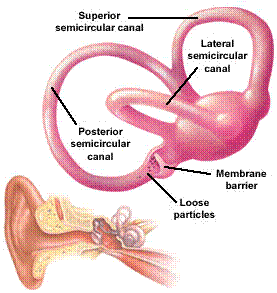
Anatomy of internal ear and the balance organ (vestibular apparatus) located inside. The loose bony particles (otoconia) irritate the nerves and cause dizzines
Vestibular migraine
Vestibular migraine is the association of vertigo and migraines. It is the second most frequent cause of recurrent vertigo with a lifetime occurrence rate of about 1%.
Ménière’s disease
Ménière’s disease frequently presents with vertigo in combination with ringing in the ears, a feeling of pressure or fullness, severe nausea or vomiting, and hearing loss. As the disease worsens, hearing loss will progress.
Vestibular neuritis
Vestibular neuritis presented with severe vertigo. It is believed to be caused by a viral infection of the inner ear. Persisting balance problems may remain in 30% of people affected.
Motion sickness
Motion sickness is one of the biggest symptoms of vertigo and it develops most often in persons with inner ear problems. The feeling of dizziness and lightheadedness is often accompanied by nystagmus. This is when the eyes rapidly jerk to one side and then slowly find their way back to the original position. During a single episode of vertigo, this action will occur repeatedly. Symptoms can fade while sitting still with the eyes closed.
How will your doctor examine for vertigo?
Dix -hallpike’s test
The Dix-Hallpike test is performed with the patient sitting upright with the legs extended. The patient’s head is then rotated by approximately 45 degrees. The clinician helps the patient to lie down backwards quickly with the head held in approximately 20 degrees of extension. This extension may either be achieved by having the clinician supporting the head as it hangs off the table or by placing a pillow under their upper back. The patient’s eyes are then observed for about 45 seconds as there is a characteristic 5-10 second period of latency prior to the onset of nystagmus. If rotational nystagmus occurs then the test is considered positive for benign positional vertigo. During a positive test, the fast phase of the rotatory nystagmus is toward the affected ear, which is the ear closest to the ground. The direction of the fast phase is defined by the rotation of the top of the eye, either clockwise or counter-clockwise.
How is vertigo treated?
Vertigo is treated by an expert Neurologist in following ways:
- Epley’s maneuvers performed in the clinic
- Daily exercise designed to ensure clearance of the debris (otoconia) and facilitate full resolution of vertigo symptoms.
- Drugs- betahistine, cinnarizine, prochlorperazine, etc.
How is Epley’s maneuver performed?
The Epley maneuver is also called the particle repositioning or canalith repositioning procedure. It was invented by Dr. John Epley, and is illustrated in figure. It involves sequential movement of the head into four positions, staying in each position for roughly 30 seconds. The recurrence rate for BPPV after these maneuvers is about 30 percent at one year, and in some instances a second treatment may be necessary.
What exercises should be performed to treat vertigo?
Please refer to the following illustration:
